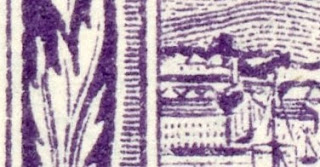1899 Tasmania 2 1/2p dark blue
"Tasman's Arch"
Engraved, Perf 14, Wmk 78 "Multiple TAS"
Into the Deep Blue
This post will mainly look at the varieties of the1899-1912 Tasmanian Pictorials Two Pence violet.....
1899 Tasmania Scott 88 (SG231) 2p violet "View of Hobart"
Engraved, Perf 14, Wmk 78 "Multiple TAS"
In 1899, De La Rue of London produced the engraved Two Pence, showing a view of Hobart, the capital of Tasmania. The population of Hobart in 1900 was approximately 50,000.
CV is $25 (unused).
As mentioned in the previous post, the plates were then shipped to Melbourne, where later issues (either lithographic or electrotype) were printed.
1902 Tasmania Scott 97 (SG239) 2p violet
Lithographic, Perf 12 1/2, Wmk 70 "V over Crown"
The lithographic printing (from transfers of the De La Rue plates) of the Two Pence was released in January, 1902. Perf was commonly 12 1/2 or 11 (there are rarer perf combinations). The lithographic 2p stamp was on Wmk "V over Crown" paper. The watermark is sideways.
How can one tell a stamp is a lithographic printing besides checking the perf (remember the engraved stamps were Perf 14), and the watermark?
Close-Up: 1902 Tasmania Scott 97 (SG239) 2p violet
Lithographic, Perf 12 1/2, Wmk 70 "V over Crown"
See the building with
three rows of windows next to the water on the extreme left of the pictorial Hobart scene? The three rows indicate this is a lithographic print, as the electrotype version has only
two rows of windows, as we will see in a bit.
And the engraved version, although also having three rows, is a different Perf (14) and a different Wmk (78).
CV is $14 (unused).
There was another lithographic Two pence stamp produced in 1905, but on "Crown over A" watermarked paper. CV is ~$16 unused. I don't have a copy, but it can be Perf 12 1/2 or 11 commonly (rarer Perf combinations exist), It is listed as SG 245 in Stanley Gibbons, but Scott does not have a separate catalog number for it. !!!
1907 Tasmania Scott 104 (SG251b) 2p violet
Perf 11, Electrotype, Wmk 13 "Crown over A"
Beginning in 1905 and later, the watermarked paper for the Pictorial issues was switched to "Crown over A" paper. There were still lithographic printings being produced (See paragraph above), but also electrotype (typographic) printings were initiated.
The above electrotype Two Pence was issued in 1907. CV is $18 (unused).
Common Perfs are 12 1/2 and 11, with combinations Perfs also known.
How can one tell a Two Pence Electrotype printing?
Close-Up: 1907 Tasmania Scott 104 (SG251b) 2p violet
Perf 11, Electrotype, Wmk 13 "Crown over A"
Note only two rows of windows (not three) next to the water on the extreme left of the pictorial Hobart scene? This is characteristic for the electrotype printings.
1912 Tasmania Scott 117 (SG260) 1p on 2p bright violet
Surcharged in Red
On Redrawn 1911 Scott 114 (SG259)2p bright violet
Perf 12 1/2, Stereotyped (Typographic), Wmk 13 "Crown over A"
In 1911, a new stereotyped (electrotype) plate was made that created a larger stamp: 33+mm across compared to 32 mm. There care also slight changes in the clouds and other parts of the design. Most of these 1911 stamps (CV $15 unused) were red overprinted "One Penny" in 1912 - and that is the stamp I have here. CV is $2+.
Scott 117 Close-Up
Note the building only has two rows of windows for this Stereotype (Electrotype) stamp.
1899 Tasmania 2 1/2p dark blue
"Tasman's Arch"
Engraved, Perf 14, Wmk 78 "Multiple TAS"
Only the engraved De La Rue of London printing was produced, and therefore quite easy to identify. ;-)
Tasman's Arch is a tall natural stone bridge along the sea cliffs of southeast Tasmania.
CV is $25 (unused)
Out of the Blue
The Two Pence violet offers lovely complications. !! :-)
To be continued....








